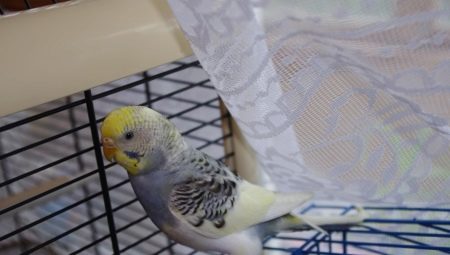Owners of domestic parrots periodically encounter the fact that the bird begins to lose feathers and fluff. Those with a lot of experience in content are usually not too worried about this. But for beginners, a large number of feathers in a cage and throughout the apartment can be confusing and even frightening. In most cases, the change of plumage is a natural and necessary process. But it happens that molting in budgies is pathological in nature.
From the article you will learn about the process of feather loss in domestic parrots and how to distinguish natural molting from signs of disease in birds.

Why does the plumage change?
For wild and domesticated birds, the process of dropping feathers is very necessary. The old plumage wears out and fouls over time. And although the birds clean their feathers, keeping them in proper condition for a very long period still fails. Without molting, most birds would lose their ability to fly over time.
After feather discharge, a new feather cover quickly grows in birds. He is healthier and stronger. The color of the individual also becomes brighter. In addition, in the process of molting, the upper layer of feathered skin is updated. And this is also very important for the health and hygiene of the individual.
In the wild, feather discharge in birds is associated with climate and changing seasons.
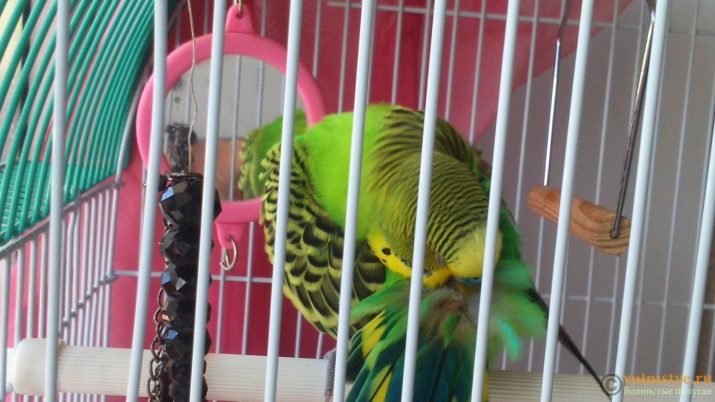
Usually molting occurs once a year, in the spring. The worn-out and thinned plumage falls out intensively, but not simultaneously, but in separate areas. This allows the individual not to "bare" and continue to fly.
Frequency and duration of molting
In parrots kept at home, the change of feather is not so tied to the season. In the apartment, the bird does not experience the influence of climatic conditions, so molting can take place at any time of the year. In budgerigars, as well as in other species, plumage is dumped 1-2 times a year.
Even in one individual, a change of feather cover can occur at different times of the year. This process is influenced by many factors: nutrition, living conditions, the health status of the parrot, possible stresses, as well as the frequency of laying eggs in females.
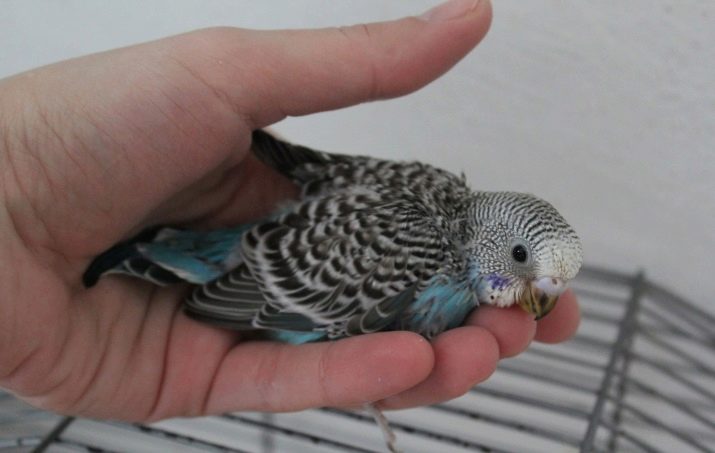
It is believed that normally the budgies contained in the apartment should molt in the spring and autumn. During these periods, you can first observe a small amount of fluff in the cell. Then, in this apartment, here and there, bird feathers will appear.
In adult parrots, the process of changing the feather cover lasts from one to one and a half months. But the first molt in chicks under the age of one year lasts much longer, sometimes up to 5-6 months.
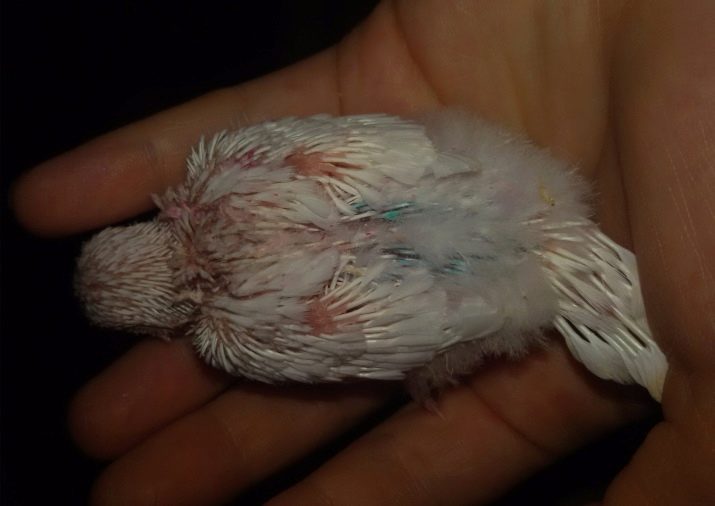
Kinds
In wild and domestic birds, there are two types of natural molting: seasonal (periodic) and juvenile.
- Feather Seasonal Reset occurs in all adults annually. If the molting does not begin naturally or is not intensive enough, the parrot can begin to pluck its plumage itself. Over the course of the process, the amount of fluff and feathers dropped is reduced, and the pet is overgrown with a new feather cover.
After molting, the color of the parrot may change slightly, this should not be scared.
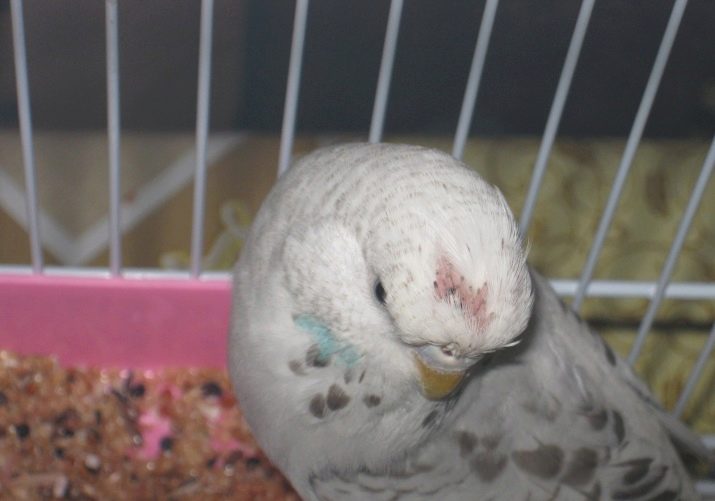
- Juvenile molting feathered cubs survive only once in their life, while they are not yet mature chicks. In individuals under the age of six months, a temporary cover grows, designed only to not freeze in the nest. It consists mainly of fluff and a very short plumage.
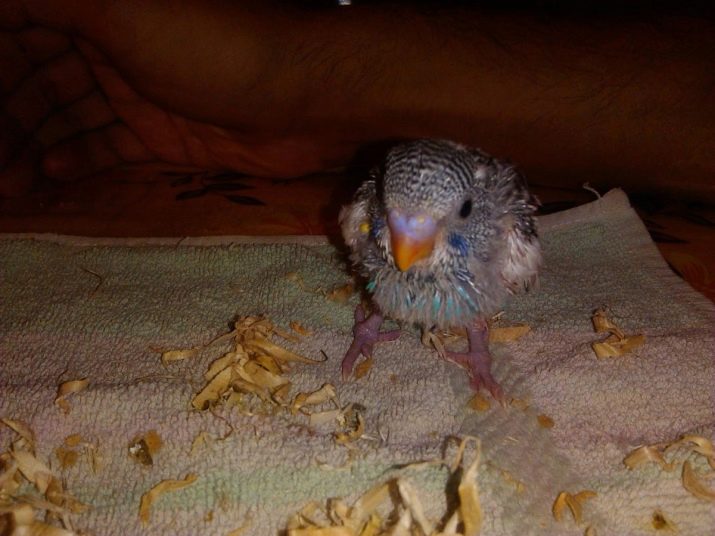
Over time, the need comes to acquire strong feathers. After all, a grown up baby will soon have to leave the nest and begin an independent life. Therefore, at the age of 3-5 months, chicks of most birds, including baby budgerigars, begin an active discharge of fluff and feathers.
Juvenile molting lasts much longer than seasonal molting. Fluff can fall out within 3-4 months, and sometimes up to six months. At the same time, the chick, unlike an adult parrot, can become completely naked for some time. Visually, this is not a very pleasant picture, but the first molt cannot be avoided, since it is associated with the onset of puberty of the individual.
Usually, by the age of 8–10 months, the young parrot completely changes the feather cover, and it becomes possible to test the wings in flight.
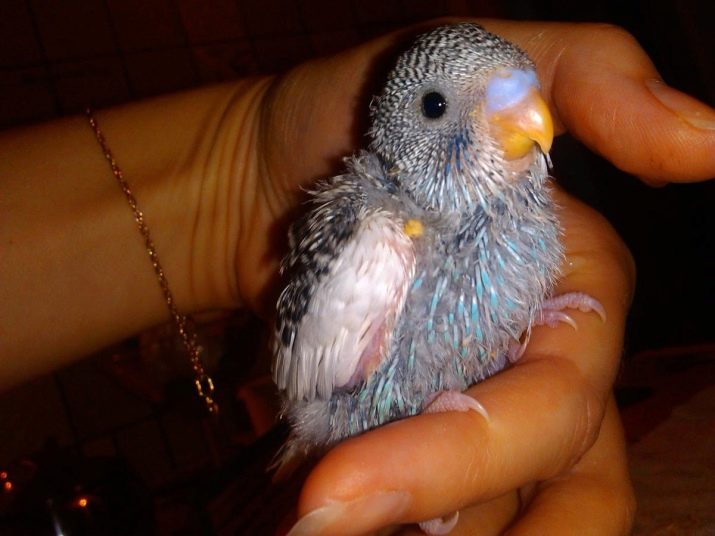
Signs
A small amount of fallen down or small feathers in a cage or in an apartment can be observed almost constantly.
This does not always mean that the pet is preparing to survive a real molt.
The following symptoms indicate the beginning of a natural seasonal discharge of the pen:
- dandruff appears on the skin of a bird;
- feathers on the head and neck become uneven, disheveled and clearly thinned out;
- the pattern on the back and wings fades, becomes fuzzy;
- sometimes your feathered bird actively nips down with its beak, trying to scratch its paw;
- numerous white columns appear on the skin;
- a parrot can suddenly become aggressive, behave unusually;
- the bird breaks its usual daily routine, the parrot does not sleep well, or, on the contrary, is too sluggish during wakefulness;
- feathered may refuse the usual food, the amount of food consumed is markedly reduced;
- the bird tries to retire, hides, does not make contact.

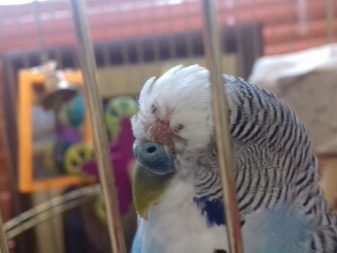
Bird Care
Since the living conditions of a domestic budgerigar are completely dependent on the owner, it is important to make it as comfortable as possible during molting.In the natural environment, birds have more opportunities to find means to discharge feathers as quickly as possible and with less inconvenience. For example, wild birds can independently find the food that contains the currently essential nutrients and trace elements. Birds also use branches and tree trunks to rub against them and accelerate the loss of old fluff and feathers.
For a parrot contained in the apartment, it is very desirable to create conditions close to natural for the period of molting change.
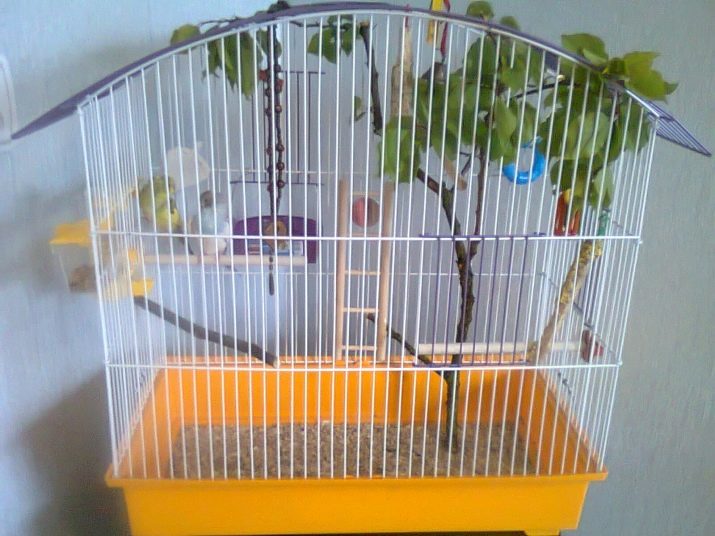
It is also important to ensure that he receives additional vitamins and minerals from the feed.
- A stable temperature in the apartment should be maintained. Eliminate drafts in the place where the bird cage is located.
- When the feather cover changes, the skin of the parrot becomes irritated and dry. Therefore, in the room for molting, you need to provide additional humidification.
- Place several twigs in the cage. About them, the parrot will be able to rub and accelerate the release of feathers.
- During molting, many individuals in parrots disturb sleep. Therefore, try to reduce the amount of irritants in those hours when your feathered pet usually sleeps.
- It is believed that during the seasonal change of plumage the parrot should not be released from the cage due to the fact that it will fall during the flight. This point of view is not entirely true, since the discharge of feathers from the wings occurs gradually and symmetrically. Due to this, birds in the wild retain the ability to fly.

The same sequence of dropping feathers is inherent in domestic parrots. Only in the midst of molting can a feathered bird be able to control its flight maneuvers a little worse. But this does not last very long.
Do not deprive your budgerigar of the opportunity to swim. Thus, the bird removes irritation on the skin, gets rid of itching and dryness. It is only necessary to ensure that the feathered bird is not blew after water procedures. It is best to speed up the drying process during the feather change period by wiping the bird's body with soft napkins or a towel.

In rare cases, the parrot flatly refuses to bathe himself during molting. Then it is necessary at least once a day to pour it with a stream of warm water or spray it over the cage with a spray gun.
During seasonal molting, it is necessary to ensure that an additional amount of vitamins and nutrients enter the body of the bird. This will strengthen the immune system and prevent general weakening.
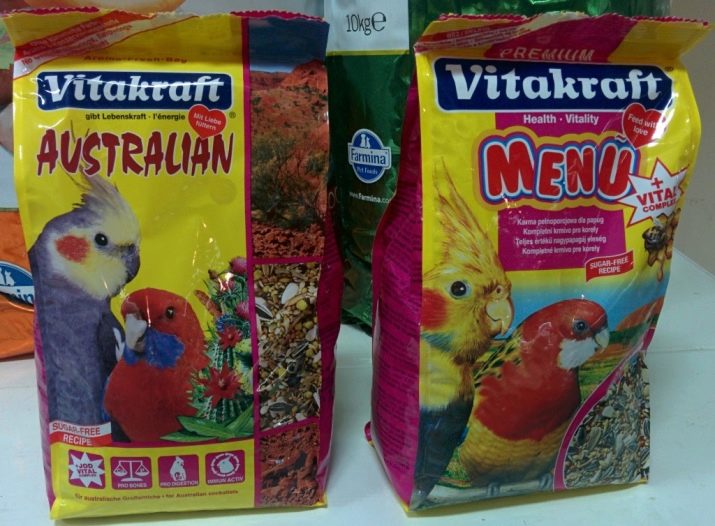
Ready-made special feeds are on sale, the packaging of which is marked “for feeding during molting”. They should be the basis of the menu for several weeks, while the parrot is changing feather cover.
Also in the diet of the feathered you need to include:
- vegetables (pumpkin, carrots, beets);
- berries (currants, grapes);
- fruits (pears, apples, bananas);
- greens;
- protein-containing foods (low-fat cottage cheese, eggs);
- top dressing with mineral elements (chalk, crushed eggshell, sepia).
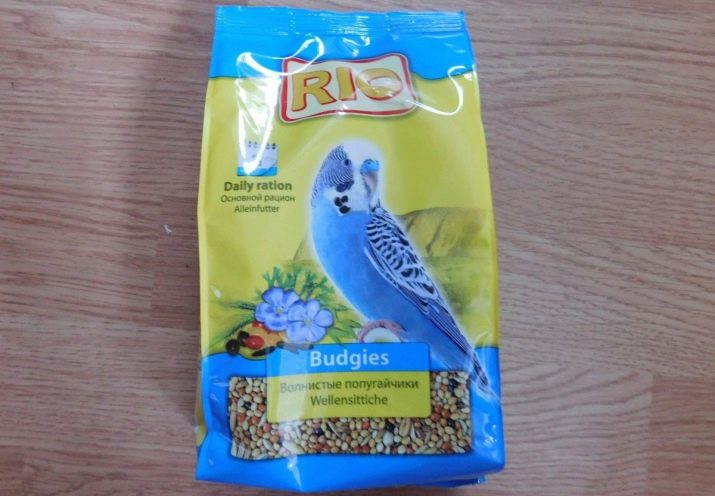
Violations and pathologies
Intense feather loss by domesticated birds is not always natural and healthy. It happens that a parrot sheds due to any disease or pathological disorder.
The owner should be wary if:
- the next molt in the budgerigar came too quickly and is already the third or fourth in a year;
- the adult individual is very “bare”, and the new plumage grows very poorly;
- the parrot overly actively pulls out its feathers with its beak for several days;
- along with the loss of feathers and fluff, a complete rejection of food is observed, the bird is very sluggish and disinhibited.
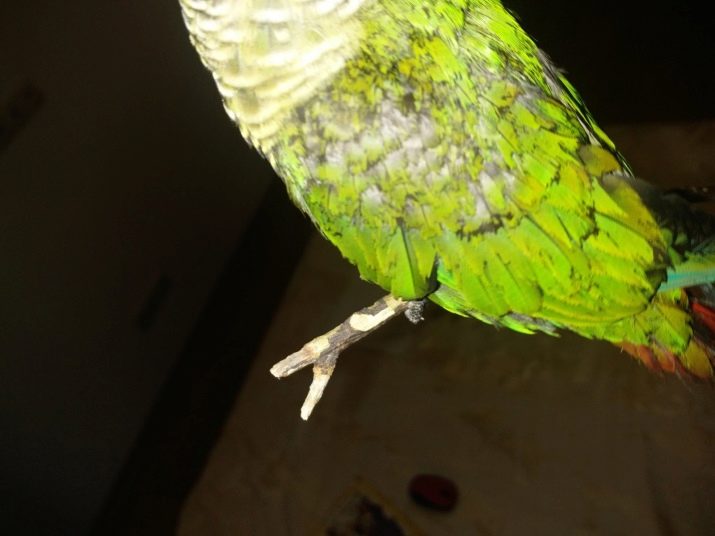
Pathological conditions of domestic parrots, requiring contact with an ornithologist:
- So-called French molting is not natural. The feather cover of the bird falls out almost completely, and the new plumage does not grow.The disease is most often affected by young chicks who have not reached puberty. However, it is not uncommon for adults to suffer from French molt. The causes of the pathology are not yet fully understood. It is believed that the process may begin due to violations in the nutrition of the bird and acute long-term lack of essential trace elements.
- Because of stress or fear, parrots can begin to pluck themselves. This is traumatic and causes considerable suffering to the bird. Usually the pathology goes away by itself when adjusting the conditions of detention.
- Scabies caused by parasites can also cause intense feather loss. With knemidocoptosis, the exposed parts of the body turn red and become lumpy. The disease is cured with the help of medications and strengthening immunity with vitamins.
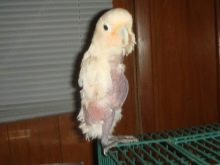


See how molting in a budgie looks like.
